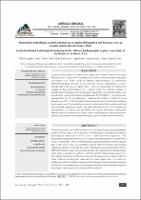Modelación hidrológica semidistribuida en la región hidrográfica del Titicaca: caso de estudio cuenca del río Ramis, Perú
Fecha
2016Palabras clave
Hidrometeorología - Caudal - Precipitación - Pronóstico Hidrológico - Modelos y Simulación - Cuencas - Modelamiento HidrológicoColecciones
Recurso(s) relacionado(s)
https://dialnet.unirioja.es/servlet/articulo?codigo=5763184Resumen
La presente investigación se realizó en la cuenca del río Ramis, ubicado en la región hidrográfica del Titicaca, Perú, con el objetivo de calibrar y validar el modelo hidrológico Sacramento (SAC-SMA) desde un enfoque semidistribuido. La información
hidrometeorológica utilizada de precipitación pluvial, temperatura y caudal, corresponden a una serie de registro 2005 – 2016. La metodología de interpolación espacial de datos meteorológicos en la estación virtual, fue estimada mediante el procedimiento de Shepard y la evapotranspiración potencial por el modelo de Turc, estas metodologías vienen incorporados en la plataforma RS-MINERVE y son estimaciones automatizadas. La fase de calibración y validación del modelo, se realizó de forma aleatoria con el 70% y 30% del total de datos respectivamente. La evaluación estadística de eficiencia y error fueron medidos a través del coeficiente de Nash, coeficiente de Nash para valores del logaritmo y raíz del error medio cuadrático relativo. Los resultados son
satisfactorios y se afirma que las salidas del modelo hidrológico representan adecuadamente los caudales de avenida y estiaje, constituyéndose como una alternativa para el fortalecimiento del pronóstico hidrológico a paso de tiempo diario del rio Ramis. The present research was held in the basin of the river Ramis, located in the hydrographic region of Titicaca, Peru, with the objective of calibrating and validating the Sacramento hydrological model (SAC-SMA) from a semi-distributed approach. The hydrometeorological information used for rainfall, temperature and flow, correspond to a
series of records 2005 - 2016. The methodology of spatial interpolation of meteorological data in the virtual station was estimated using the Shepard procedure and potential
evapotranspiration by the model Turc, these methodologies are incorporated in the RSMINERVE platform and are automated estimates. The calibration and validation phase of the model was performed randomly with 70% and 30% of the total data respectively.
The statistical evaluation of efficiency and error were measured by the Nash coefficient, Nash coefficient for logarithm values and root mean square error. The results are satisfactory and it is stated that the outputs of the hydrological model adequately represent the flows of avenue and drought, constituting as an alternative for the strengthening of the hydrological forecast at the daily time step of the river Ramis.
El ítem tiene asociados los siguientes ficheros de licencia:








